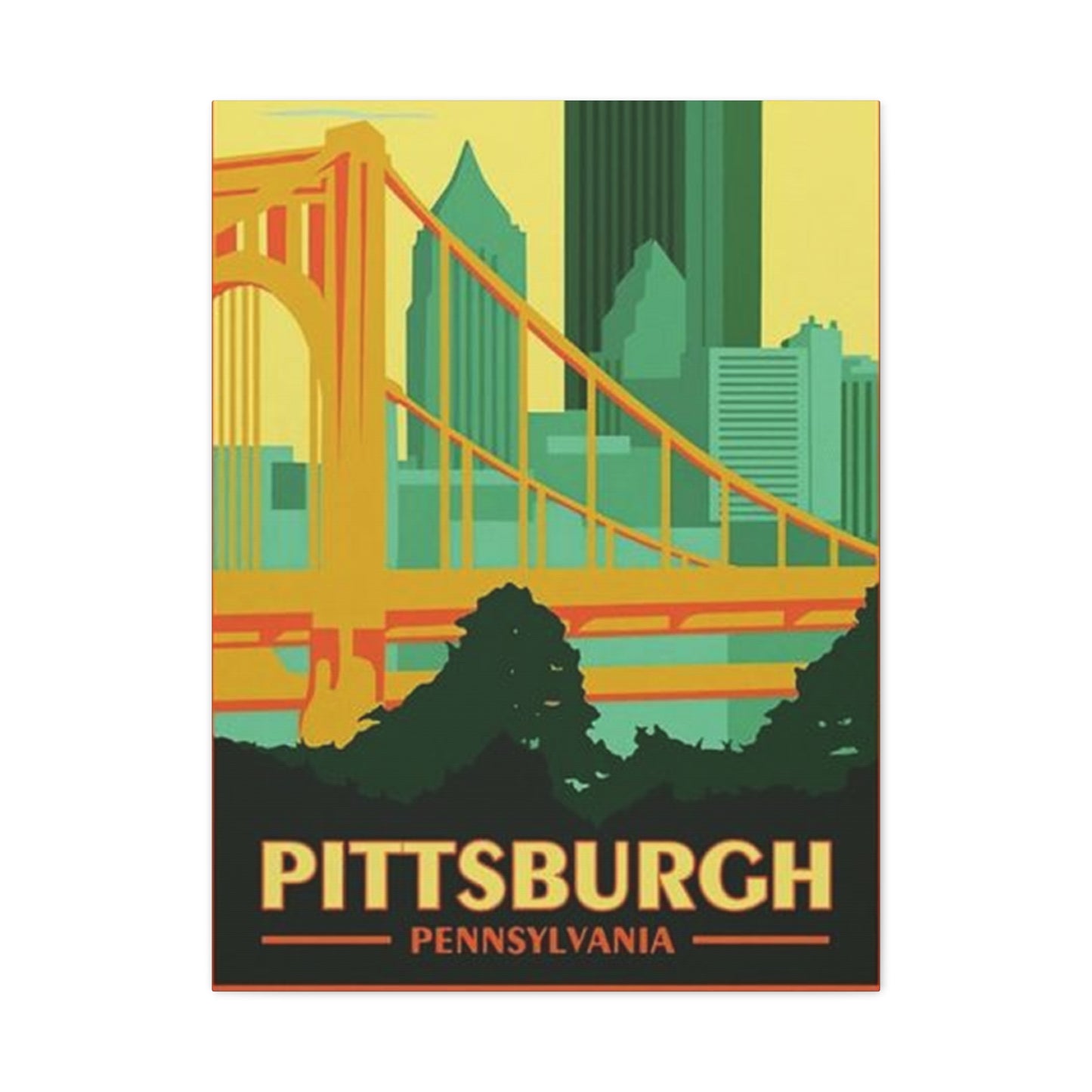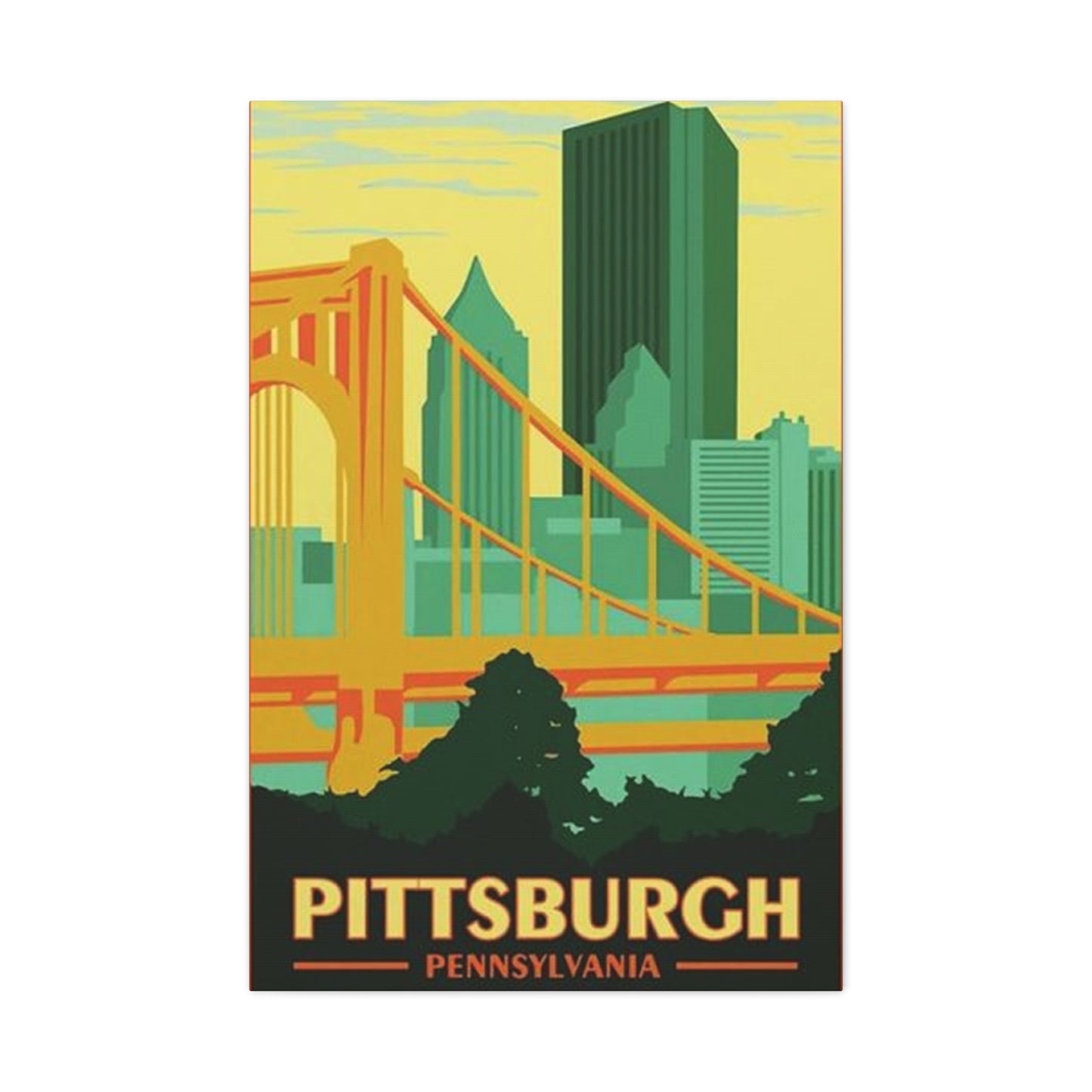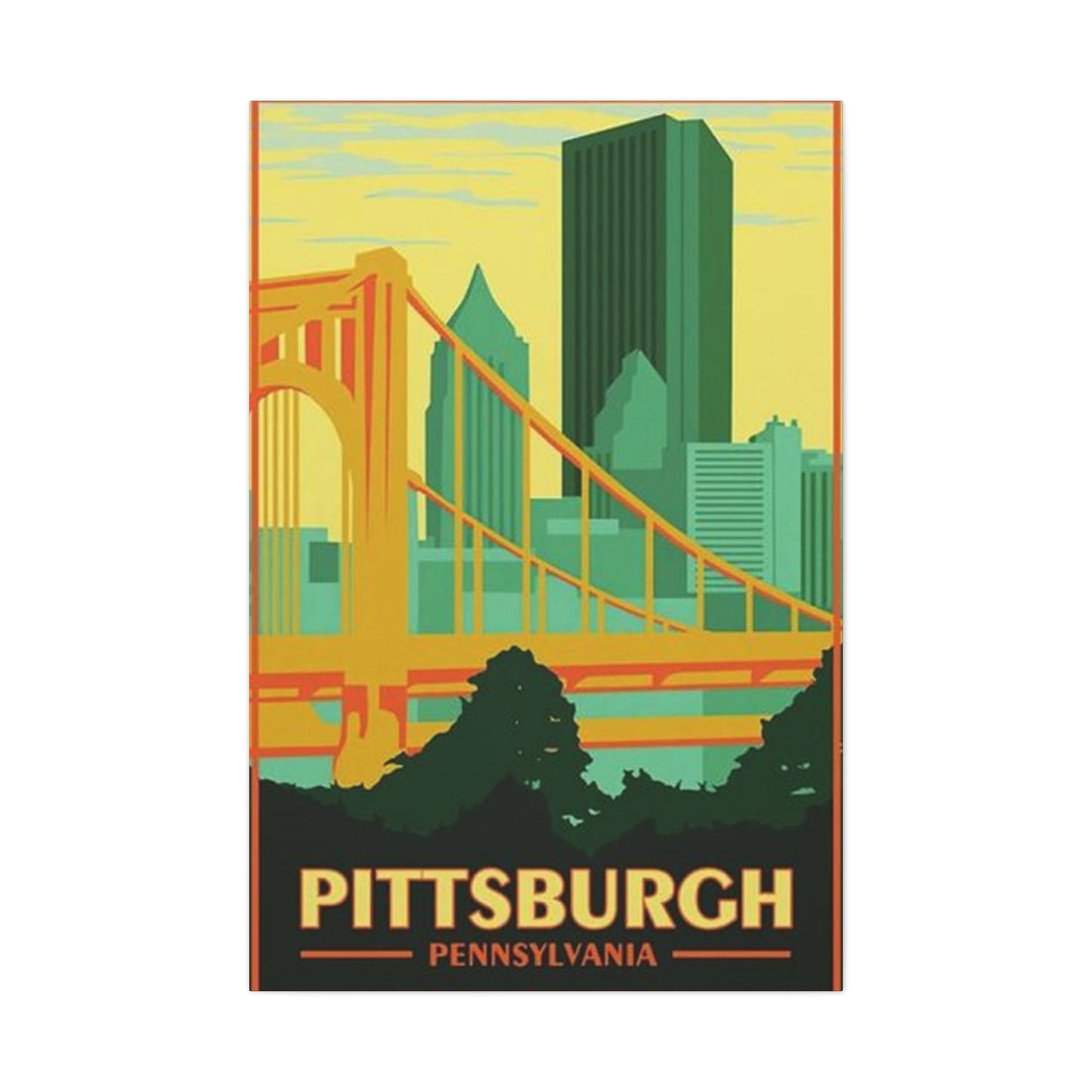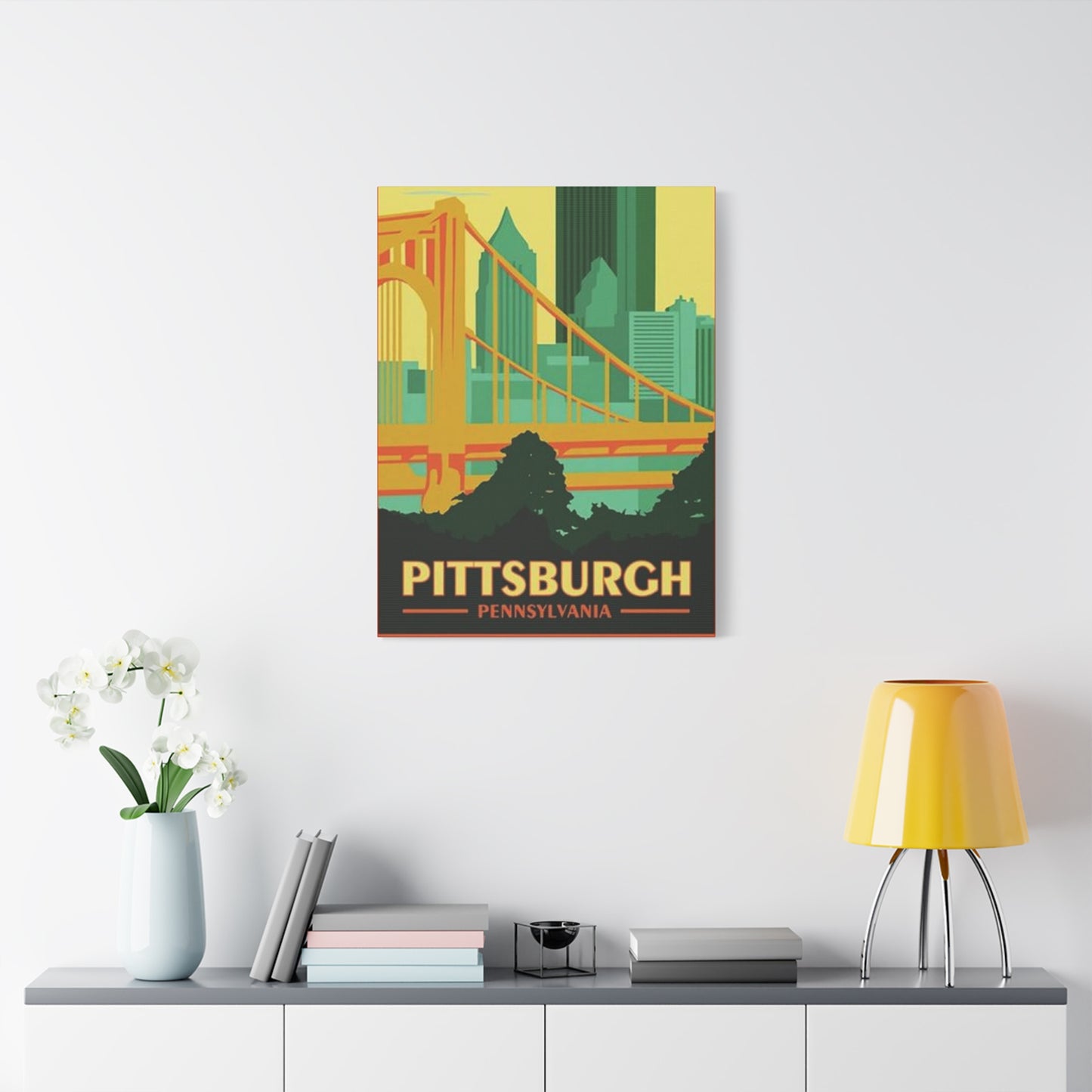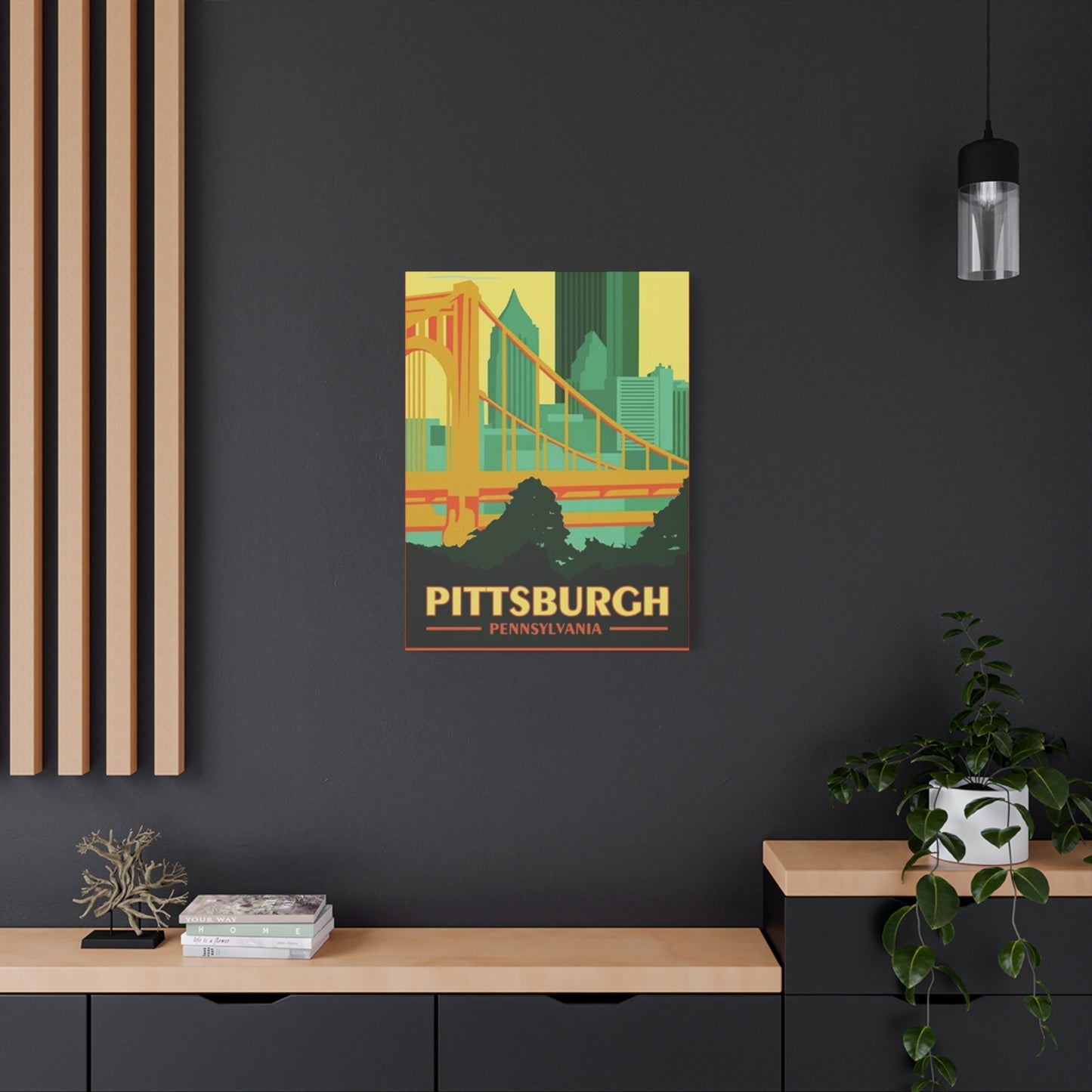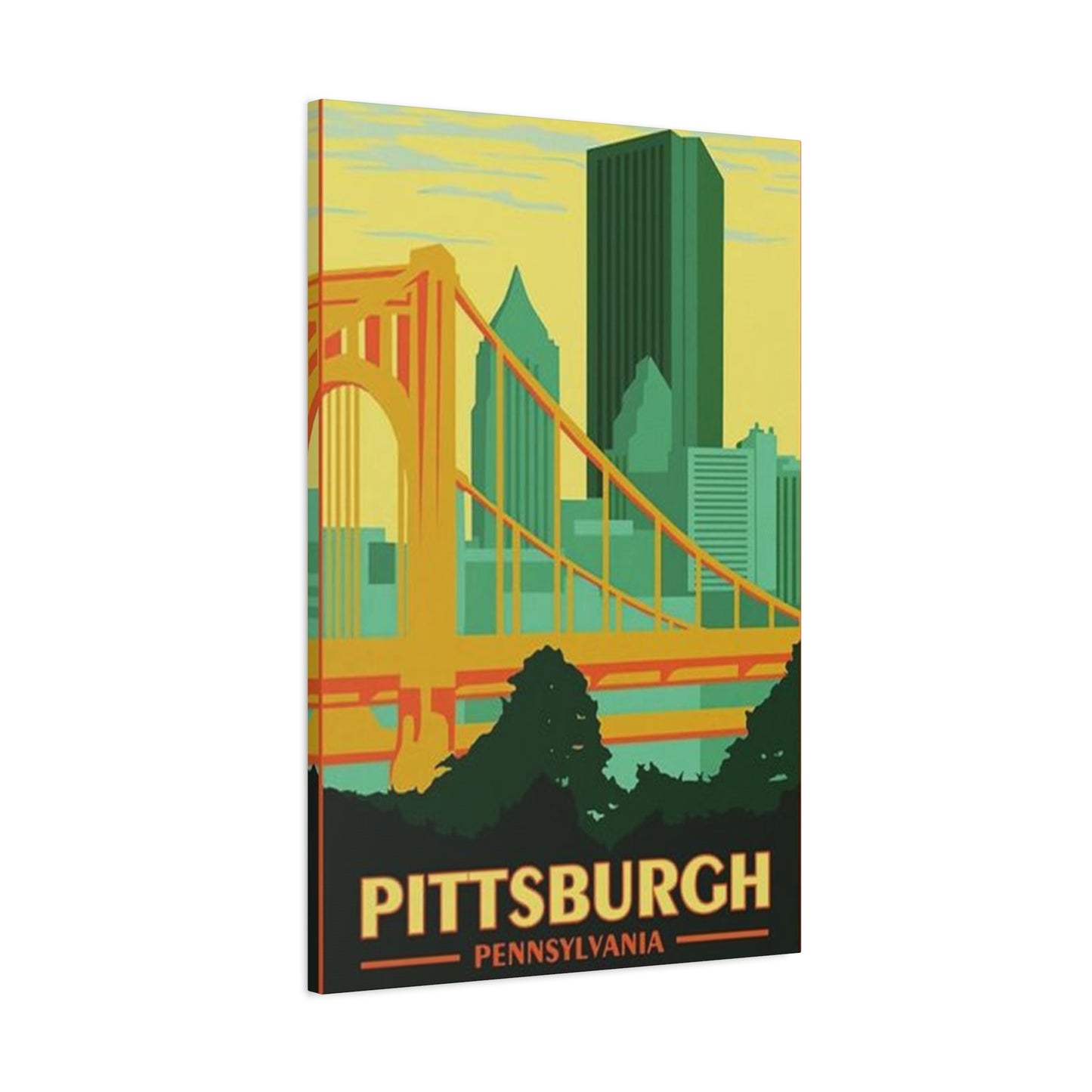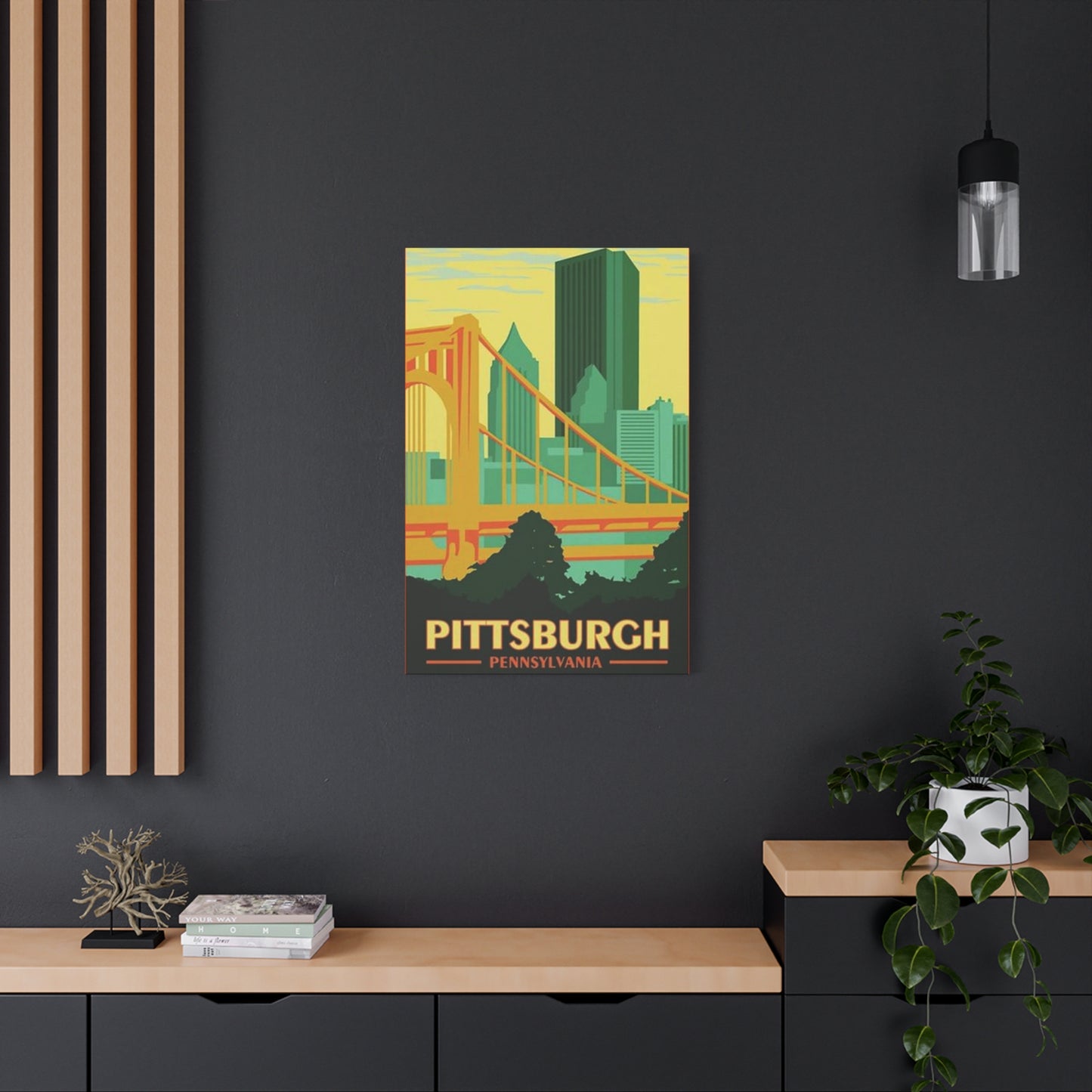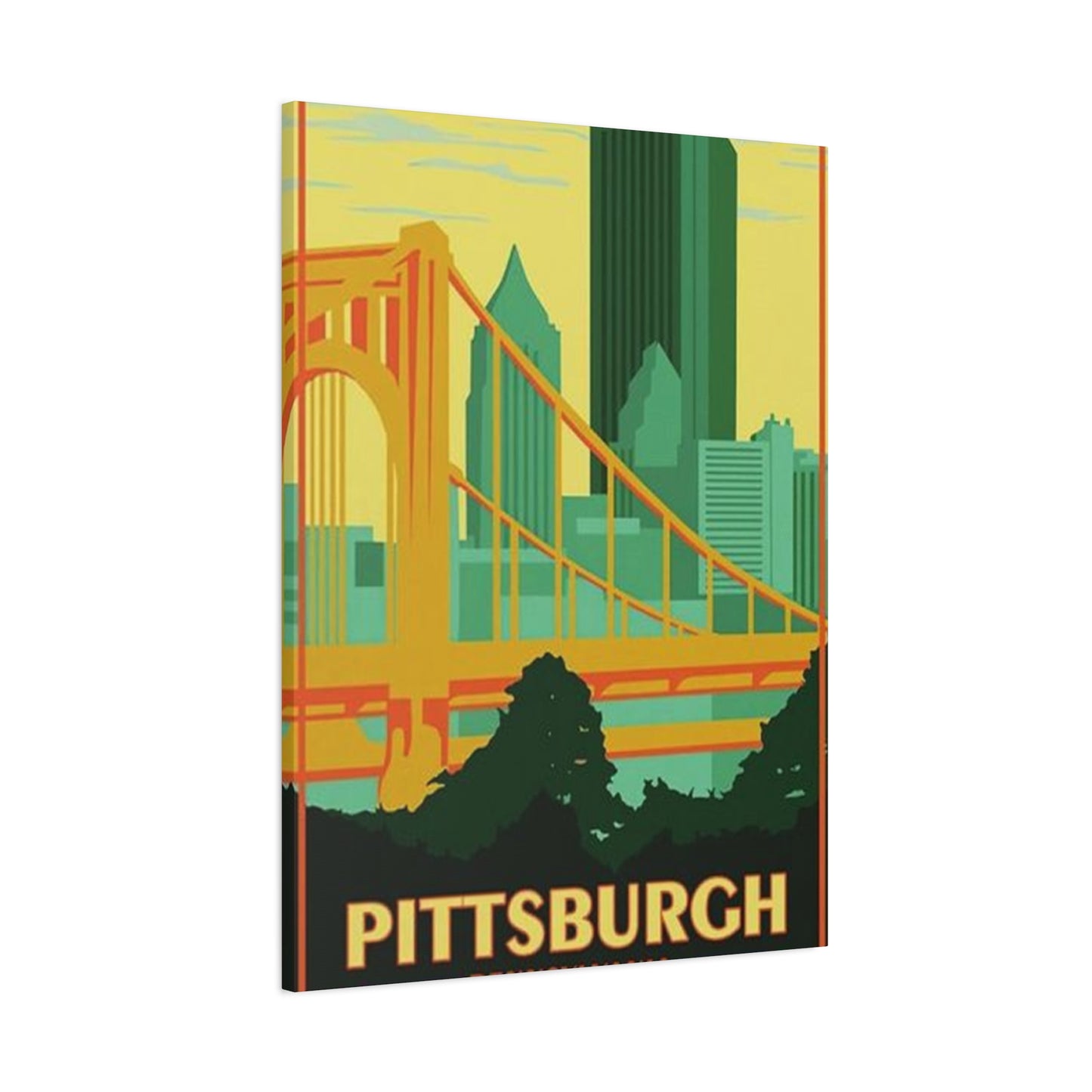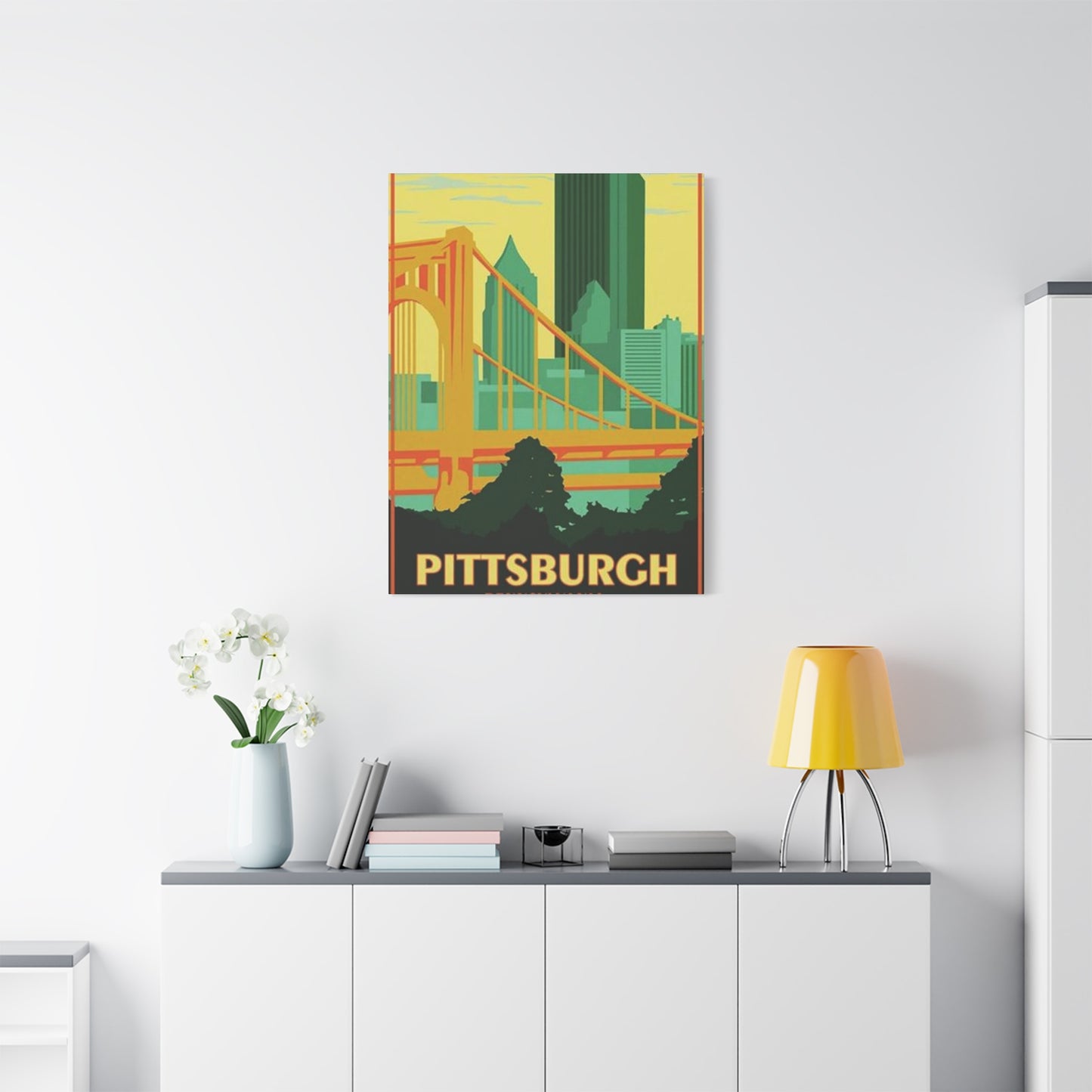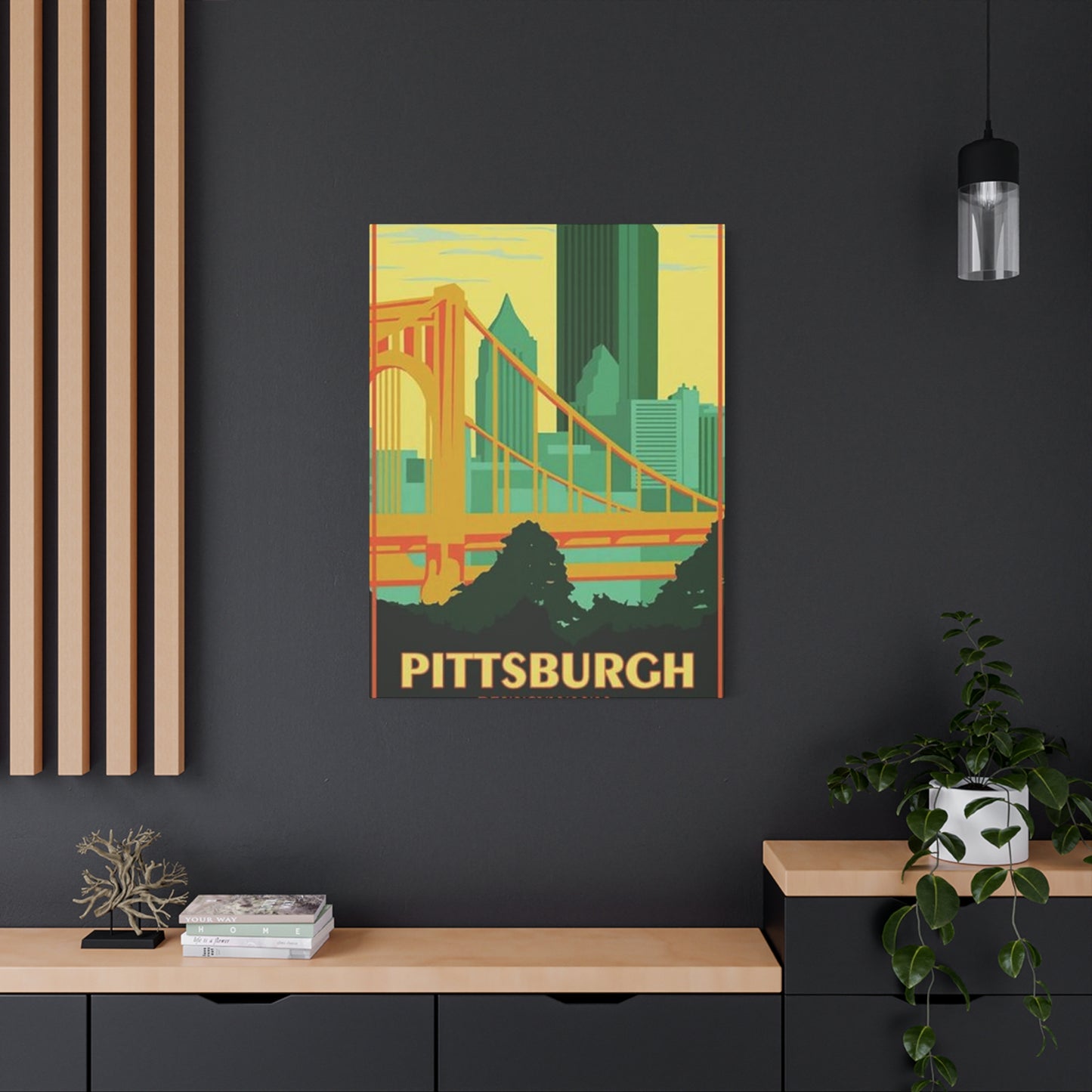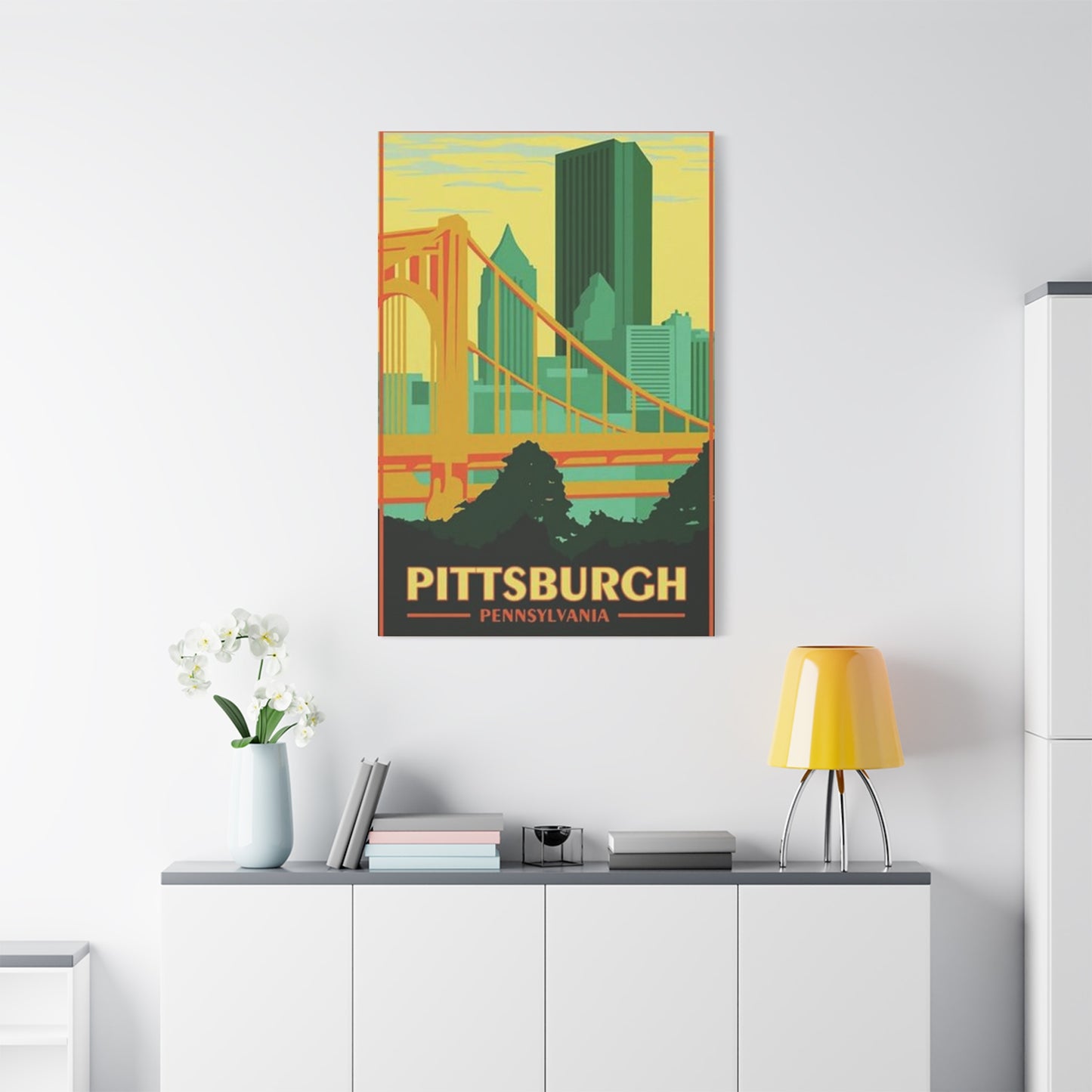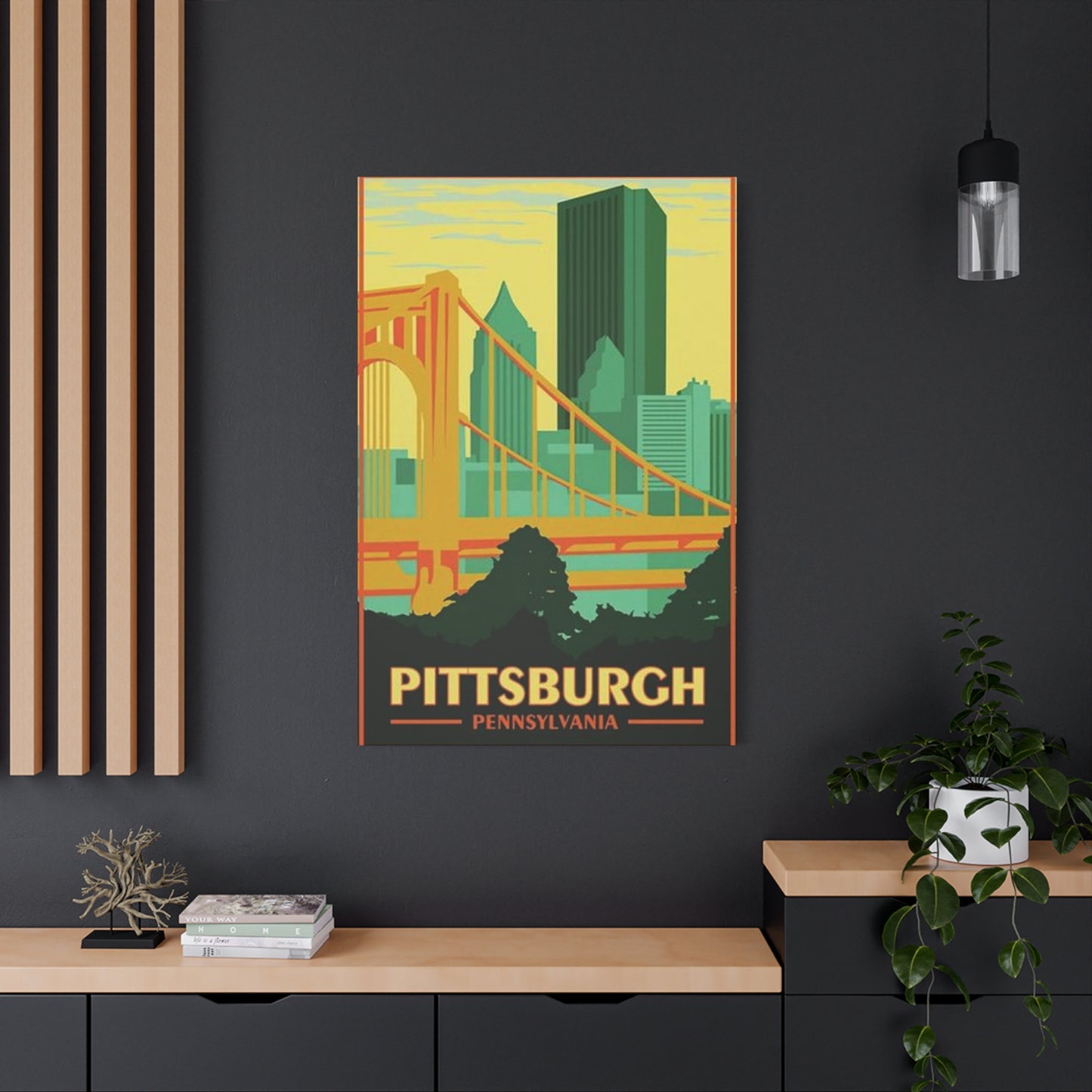Pittsburgh's Steel Bridges in Wall Art: Celebrating Heritage Through Design
Pittsburgh stands as a testament to American industrial achievement, where rivers converge and steel structures span waterways with remarkable grace. The city's architectural heritage comes alive through artistic representations that capture decades of engineering excellence. These metal structures have become more than transportation routes; they represent an era of innovation that shaped the nation's infrastructure development.
Visual representations of these engineering achievements bring historical significance into living spaces, creating connections between past accomplishments and present aesthetics. Artists and photographers have long been captivated by the way light plays across metal frameworks, creating dramatic shadows and highlighting geometric patterns that define these structures. The visual appeal extends beyond mere documentation, offering viewers an opportunity to appreciate the artistry inherent in functional design.
When incorporated into residential or commercial environments, these artistic pieces serve multiple purposes. They honor regional heritage while providing striking focal points that command attention without overwhelming a space. The interplay of structural elements creates visual interest through repetition, symmetry, and the inherent beauty of engineering precision. Each structure tells its own story through unique architectural features, from suspension cables to arch supports, offering endless variety for artistic interpretation.
The popularity of such artwork reflects a broader cultural appreciation for industrial heritage and the recognition that functional structures can possess aesthetic merit. Collectors and design enthusiasts seek these pieces not only for their visual impact but also for their ability to spark conversation about history, progress, and the relationship between form and function. The enduring appeal lies in how these representations balance technical achievement with artistic vision.
Photography and illustration techniques allow artists to emphasize different aspects of these structures, from close-up details of rivets and beams to sweeping panoramic views that place them within their urban context. This versatility makes them suitable for various design schemes, whether someone seeks dramatic statement pieces or subtle nods to industrial aesthetics. The range of available styles ensures that there's an interpretation to match every taste and interior vision.
Bringing Pittsburgh's Steel Legacy into Your Home
The transformation of industrial imagery into residential decor represents a fascinating evolution in how people connect with their environment and history. Selecting artwork that features metal framework structures allows homeowners to celebrate regional identity while embracing design trends that value authenticity and character. These pieces bridge the gap between industrial heritage and contemporary living, creating spaces that feel both rooted in tradition and forward-thinking.
Incorporating such elements into home design requires thoughtful consideration of scale, placement, and surrounding decor. Large-format pieces work exceptionally well in spaces with high ceilings or expansive walls, where their grandeur can be fully appreciated. The dramatic lines and structural elements naturally draw the eye upward, making rooms feel more spacious and dynamic. Smaller prints can be grouped to create gallery arrangements that tell a more comprehensive story about the city's architectural landscape.
Color palettes in these artworks range from monochromatic studies that emphasize form and shadow to vibrant interpretations that capture sunset light reflecting off metallic surfaces. This variety allows for seamless integration into existing color schemes while providing opportunities to introduce new accent tones. The neutral foundation of steel gray, black, and white makes these pieces remarkably versatile, complementing everything from minimalist modern interiors to more traditional settings with rich wood tones.
The emotional resonance of these images extends beyond visual appeal. For residents with personal connections to the region, such artwork serves as a daily reminder of home, heritage, and the values of hard work and innovation that defined generations. Visitors often find themselves drawn to these pieces, sparking conversations about travel experiences, architectural interests, or shared appreciation for industrial design. This ability to create dialogue and connection makes such artwork particularly valuable in social spaces.
Durability and quality of reproduction matter significantly when selecting pieces for long-term display. High-quality printing techniques preserve fine details and tonal ranges, ensuring that the artwork maintains its impact over years of display. Archival materials prevent fading and deterioration, protecting the investment while maintaining the visual integrity that makes these pieces special. Frame selection further enhances longevity while contributing to the overall aesthetic presentation.
Why Steel Bridge Posters Make a Bold Statement in Urban Decor
Urban living environments benefit tremendously from design elements that acknowledge and celebrate city life's unique character. Representations of architectural achievements fit naturally into this aesthetic, providing visual anchors that resonate with the energy and dynamism of metropolitan spaces. The bold lines and geometric precision of these structures complement contemporary interior design principles while adding layers of meaning and context.
The graphic quality of such imagery lends itself particularly well to modern decorating approaches that favor clean lines, strong contrasts, and impactful visual statements. Unlike softer, more organic subjects, the angular nature of structural elements creates tension and interest that energize a space. This quality makes them ideal for areas where you want to inspire focus and creativity, such as home offices, studios, or collaborative workspaces.
Scale plays a crucial role in the impact of these pieces. Oversized prints command attention and serve as room-defining elements, establishing the overall tone and atmosphere of a space. The verticality of many structural compositions can make ceilings appear higher and rooms feel more expansive, a particularly valuable effect in urban apartments or condominiums where square footage may be limited. Strategic placement near windows or light sources enhances their three-dimensional quality as shadows shift throughout the day.
The monumental nature of the actual structures translates remarkably well to wall displays, carrying that sense of grandeur into personal spaces. This connection to something larger than everyday domestic life adds perspective and inspiration to daily routines. Morning coffee takes on new dimension when enjoyed while contemplating engineering achievements that have served communities for decades. The artwork becomes not just decoration but a daily touchstone connecting inhabitants to broader narratives of progress and community.
Versatility in styling options makes these pieces accessible to various design preferences. Minimalist frames allow the imagery to speak for itself, while more elaborate framing can integrate the artwork into traditional settings. The option to display prints unframed or mounted on various substrates offers additional creative possibilities for those seeking industrial or gallery-style presentations. This adaptability ensures relevance across changing design trends and personal style evolution.
Celebrating Pittsburgh's Engineering Marvels Through Art
The intersection of engineering and artistic expression creates a unique category of visual culture that honors both technical achievement and aesthetic sensibility. When artists turn their attention to structural accomplishments, they reveal beauty in precision, strength in form, and grace in function. This dual appreciation transforms utilitarian objects into subjects worthy of contemplation and celebration.
Historical context enriches the viewing experience, as each structure carries stories of the eras during which they were built. The materials, techniques, and designs reflect technological capabilities and aesthetic preferences of their times, creating visual timelines of progress. Artists who capture these subjects help preserve this history, making it accessible to new generations who may not fully grasp the innovation these structures represented when first constructed.
The technical challenge of building across waterways required solutions that pushed the boundaries of what was possible with available materials and knowledge. Artists documenting these achievements help viewers appreciate the problem-solving brilliance involved in their creation. Detailed close-ups can highlight construction methods, revealing the human ingenuity behind monumental projects. Wider perspectives show how these structures integrate into their surroundings, becoming defining features of the landscape they inhabit.
Artistic interpretation adds layers of meaning beyond documentary photography. Through choices in lighting, composition, angle, and post-processing, artists guide viewers to see familiar structures in new ways. A silhouette at dawn emphasizes form and proportion. Dramatic storm lighting suggests strength and endurance. Golden hour glow celebrates beauty in industrial design. Each approach offers different insights into the character and significance of these engineering achievements.
The community's relationship with these structures evolves over time, from practical necessities to beloved landmarks. Artwork capturing this relationship helps document changing perspectives and uses. What began as purely functional has become symbolic, representing not just transportation routes but community identity, pride, and continuity. Artists serve as interpreters of this evolution, helping current residents and future generations understand the role these structures play in collective consciousness.
Steel Bridge Art: A Perfect Addition to Industrial-Inspired Spaces
Design movements celebrating industrial aesthetics have gained tremendous popularity in recent years, transforming warehouses, lofts, and modern buildings into living spaces that embrace raw materials and functional beauty. Within this context, artwork featuring structural elements feels particularly authentic and appropriate, reinforcing design themes while adding visual interest and depth.
The materials and textures typical of industrial design find natural harmony with imagery of metalwork and engineering. Exposed brick, concrete floors, metal fixtures, and reclaimed wood all speak the same design language as steel framework representations. This cohesion creates environments that feel intentionally curated rather than randomly assembled. Each element reinforces others, building toward a unified aesthetic vision that celebrates industrial heritage.
Open floor plans characteristic of converted industrial spaces benefit from strategic artwork placement that helps define different functional zones without requiring physical barriers. Large-scale prints can anchor seating areas, delineate dining spaces, or establish office zones within larger open areas. The visual weight of these pieces provides necessary definition while maintaining the spacious, flowing quality that makes such spaces appealing.
Lighting considerations become particularly important when displaying these works in industrial settings. Track lighting or exposed fixtures can be aimed to highlight specific pieces, creating drama and emphasis. The metallic subjects often feature reflective surfaces that interact beautifully with direct lighting, creating additional visual interest through highlights and glare that change based on viewing angle. Natural light from large industrial windows creates different effects throughout the day, keeping the artwork dynamic and engaging.
The authenticity of featuring actual structural imagery in industrial spaces cannot be overstated. Rather than merely imitating an aesthetic, these pieces represent genuine examples of the industrial heritage that inspired the design movement. This authenticity resonates with occupants and visitors who appreciate the connection between form and content. The artwork becomes more than decoration; it becomes a statement of values and aesthetic philosophy.
The Charm of Pittsburgh's Bridges in Black and White Prints
Monochromatic photography possesses unique qualities that color imagery cannot replicate. By removing color information, black and white prints direct attention to fundamental visual elements: form, texture, contrast, tone, and composition. This reduction to essentials often reveals aspects of subjects that color might obscure, allowing viewers to perceive structural beauty with new clarity and appreciation.
The metallic nature of steel structures translates exceptionally well to grayscale representation. The natural gray tones of metal create smooth tonal transitions that are preserved and emphasized in black and white treatment. Highlights on polished surfaces become dramatic focal points, while shadows in structural recesses add depth and dimension. This interplay of light and dark creates visual rhythm that guides the eye through the composition.
Timeless quality characterizes successful black and white imagery, allowing it to transcend temporary trends and maintain relevance across changing design fashions. While color palettes shift with seasons and style movements, monochromatic work remains consistently appropriate. This longevity makes black and white prints sound investments for those building art collections or designing spaces intended to remain relevant over many years.
The emotional tone of black and white imagery differs markedly from color photography. There's a contemplative, sometimes nostalgic quality that emerges when color is removed. Viewers often perceive monochromatic work as more serious, artistic, or historically significant. This perception enhances the gravitas of structural subjects, reinforcing their importance and encouraging thoughtful consideration of their engineering and aesthetic qualities.
Integration into various design schemes becomes remarkably simple with black and white artwork. These pieces complement virtually any color palette, from all-white minimalist interiors to richly colored traditional spaces. They can serve as neutral anchors around which other design elements are arranged, or they can provide sophisticated contrast to colorful surroundings. This versatility makes them particularly valuable for those who enjoy refreshing their spaces periodically without replacing major design elements.
How to Style Your Space with Steel Bridge Art
Creating cohesive interior environments requires attention to relationships between all visual elements within a space. When introducing artwork featuring industrial structures, consider how these pieces interact with existing furniture, architectural features, and decorative accessories. Successful integration enhances both the artwork and the overall room design, creating harmonious environments that feel complete and intentional.
Furniture placement should consider sightlines to featured artwork, ensuring pieces are visible from primary seating areas and entry points. In living rooms, positioning sofas and chairs to allow comfortable viewing of wall art creates natural focal points and encourages guests to notice and appreciate displayed pieces. In dining areas, artwork visible from the table becomes part of the meal experience, providing conversation subjects and visual interest during gatherings.
Layering textures and materials creates depth and interest in rooms featuring this type of artwork. Soft textiles like throw blankets, area rugs, and upholstery provide tactile contrast to the hard edges and metallic subjects in the artwork. Natural materials including wood, leather, and stone add organic elements that prevent spaces from feeling too industrial or cold. This balance between hard and soft, industrial and natural, creates inviting environments that celebrate structural aesthetics without sacrificing comfort.
Complementary artwork and accessories can reinforce themes without creating redundancy. Historical photographs of industrial scenes, vintage maps, architectural drawings, or abstract pieces with strong geometric elements all relate to structural themes while offering variety. Sculptural objects featuring metal or industrial materials extend design themes into three dimensions, adding another layer of visual interest. Plants and greenery provide life and color while softening industrial edges.
Lighting deserves careful consideration both for practical illumination and for enhancing artwork presentation. Picture lights mounted above framed pieces provide focused illumination that highlights details and creates gallery-quality display conditions. Adjustable track lighting offers flexibility to emphasize different pieces or adapt to changing displays. Natural light should be managed to prevent direct sunlight from fading prints while taking advantage of daylight's ability to reveal subtle tonal variations and details.
Pittsburgh's Steel Bridges: A Symbol of Strength and Innovation
The symbolic significance of engineering achievements extends far beyond their practical functions. These structures represent human capability, determination, and the drive to overcome obstacles. When geographical features like rivers present challenges to movement and commerce, the response through engineered solutions demonstrates problem-solving ingenuity and community commitment to progress and connection.
Material choice reflects both available resources and technological advancement. The use of steel in these structures coincided with America's industrial expansion and the region's role as a manufacturing center. This connection between local industry and infrastructure creates a complete narrative about regional identity and economic development. The structures became both products of local manufacturing and symbols of what that industry made possible.
Longevity and durability of these engineering works speak to quality of design and construction. Many structures continue serving their intended purposes decades after completion, testament to the skill and foresight of their creators. This endurance through changing conditions and increasing demands demonstrates the value of thoughtful planning and quality execution, lessons applicable far beyond structural engineering.
Innovation in construction techniques often occurred in response to specific site challenges. Varied water depths, current strengths, soil conditions, and span requirements demanded customized solutions. Engineers couldn't simply replicate previous designs but had to adapt and innovate for each unique situation. This necessity drove advancement in engineering knowledge and construction methods that benefited subsequent projects worldwide.
Community identity becomes intertwined with prominent local landmarks, especially those that serve daily practical functions while also defining skylines and views. These structures appear in countless photographs, postcards, and promotional materials, becoming visual shorthand for the entire region. This recognition transforms utilitarian objects into beloved community symbols that residents and former residents carry with them as touchstones of home and belonging.
Modern and Minimal: Steel Bridge Posters for Contemporary Homes
Contemporary design principles emphasizing simplicity, clean lines, and uncluttered spaces find natural alignment with certain approaches to structural imagery. When photographers or artists adopt minimalist perspectives, reducing compositions to essential elements and negative space, the results complement modern interiors perfectly. These pieces provide visual interest without introducing the complexity or busyness that would conflict with minimalist design goals.
Neutral color schemes dominant in contemporary design create ideal backdrops for artwork featuring industrial subjects. White walls serve as blank canvases that allow prints to stand out with maximum impact. Gray tones in the artwork echo popular contemporary palette choices while introducing subtle variation. Black elements provide the contrast and definition that prevent minimalist spaces from feeling washed out or lacking in character.
Scale becomes particularly important in contemporary settings where fewer decorative elements means each piece carries greater visual weight. Large-format prints make bold statements appropriate for open-concept layouts and high ceilings common in modern architecture. The generous proportions prevent artwork from getting lost on expansive walls while maintaining the uncluttered feeling that defines contemporary style. Proper scale ensures pieces anchor spaces without overwhelming them.
Framing choices for contemporary settings typically favor simplicity and clean edges. Thin metal frames in black, white, or metallic finishes enhance artwork without competing for attention. Frameless mounting options including acrylic face mounting or gallery wraps create seamless presentations that emphasize the image itself. These approaches align with contemporary preferences for streamlined presentations that eliminate unnecessary ornamentation.
The geometric nature of structural subjects provides visual interest through form rather than color or pattern. In spaces where simplicity rules and decorative elements are carefully limited, the strong lines and shapes in structural imagery offer necessary visual stimulation. The eye finds satisfaction in tracing structural elements, discovering symmetries and patterns, and appreciating the interplay of positive and negative space that skilled composition provides.
The Beauty of Pittsburgh's Skyline Captured in Steel Bridge Wall Art
Urban skylines possess distinctive characters shaped by geography, architecture, and the infrastructure connecting their various elements. When these views incorporate prominent structural features, the result captures essential aspects of city identity and character. Artists framing their compositions to include both built environment and engineered connections create comprehensive portraits of urban landscapes.
Water elements add particular beauty to skyline compositions, introducing reflections, movement, and the interplay of natural and constructed environments. Rivers create foreground interest while providing context for why structural crossings became necessary. The contrast between flowing water and static structures creates visual and conceptual tension that enriches compositions. Reflections in calm water double visual impact while adding symmetry and balance.
Seasonal and temporal variations offer endless interpretations of the same basic scenes. Winter snow transforms structural elements into graphic black lines against white. Spring blooms add color notes around industrial gray. Summer haze softens edges and creates atmospheric perspective. Autumn foliage provides warm tones that complement cool metal. These seasonal variations allow collectors to rotate artwork or select pieces that match their climate preferences and seasonal sensibilities.
Time of day dramatically affects mood and appearance in skyline imagery. Dawn light creates soft pastels and long shadows. Midday sun produces strong contrasts and saturated colors. Afternoon light warms metal surfaces and creates rich golden tones. Dusk brings deep blues and silhouettes. Night transforms structures into patterns of lights against darkness. This range allows viewers to select pieces matching their emotional preferences and the atmosphere they wish to create in their spaces.
Perspective choices by photographers and artists determine how viewers experience these scenes. Low angles emphasize height and grandeur, creating dramatic compositions that inspire awe. High vantage points provide comprehensive overviews showing relationships between different elements. Eye-level perspectives create accessible, human-scale views that feel relatable and intimate. Each approach offers different insights into the character and appeal of urban landscapes.
Elevate Your Walls with Pittsburgh's Famous Steel Bridges
Personal spaces deserve artwork that resonates emotionally while enhancing aesthetic appeal. Selecting pieces requires consideration of both immediate visual impact and long-term satisfaction. Imagery featuring significant engineering achievements offers the substance and staying power that prevents viewer fatigue, remaining interesting through repeated viewing over months and years.
Investment in quality artwork contributes meaningfully to overall home value and personal satisfaction with living environments. Well-selected pieces improve daily quality of life by creating surroundings that inspire, comfort, and please the eye. Unlike purely trendy decorative items that quickly feel dated, artwork with historical and cultural significance maintains relevance, making it a sound long-term investment in home beautification.
Personal connection amplifies artwork's value beyond mere decoration. For those with ties to specific regions, images of local landmarks create daily reminders of home, family, and personal history. Even without direct personal connection, appreciation for engineering, industrial design, or urban landscapes can make such pieces deeply meaningful. This emotional resonance transforms artwork from simple wall covering to significant personal treasure.
Curation of personal art collections allows for storytelling and self-expression through careful selection and arrangement. Building a collection around themes like industrial heritage, specific cities, or architectural subjects creates coherence while allowing for variety in specific pieces. Collections grow and evolve over time, reflecting changing tastes, new discoveries, and different life stages. This evolution makes art collecting an engaging long-term pursuit rather than a one-time decorating task.
Sharing artwork with visitors creates opportunities for connection and conversation. Distinctive pieces become talking points that reveal aspects of homeowner personality, interests, and values. Guests remember homes with interesting, meaningful artwork, and thoughtful displays demonstrate care in creating welcoming, engaging environments. These social benefits extend artwork's value beyond private enjoyment to enhancing hospitality and relationship building.
From Steel to Art: The Evolution of Pittsburgh's Bridge Prints
The transition of functional structures into artistic subjects reflects changing cultural attitudes toward industrial heritage. What previous generations might have viewed purely as utilitarian infrastructure, contemporary audiences appreciate for both historical significance and aesthetic merit. This evolution in perception has created new categories of collectible art that honor working-class heritage and celebrate engineering achievement.
Photography as an artistic medium has developed tremendously since its invention, with technological advances enabling new creative possibilities. Early documentary photography of structural projects served practical purposes, recording construction progress and final results. As photography gained acceptance as fine art, photographers began approaching these subjects with artistic intent, seeking beauty in industrial subjects and applying aesthetic principles to their capture and presentation.
Digital technology has democratized both creation and distribution of artwork featuring these subjects. Photographers can now process and edit images in ways that were impossible or extremely difficult with film-based photography. Online platforms allow artists to reach global audiences, connecting with collectors who might never have discovered their work through traditional gallery systems. This accessibility benefits both artists and collectors, expanding possibilities for both groups.
Print production quality has advanced significantly, allowing for reproduction that rivals original photography in detail and tonal range. Modern printing techniques on archival papers with fade-resistant inks ensure long-lasting quality that protects collectors' investments. Large-format printing capabilities mean that even modestly sized original images can be reproduced at impressive scales suitable for dramatic display in residential and commercial settings.
Artistic interpretation continues evolving as new generations of artists bring fresh perspectives to familiar subjects. Contemporary artists might employ techniques like long exposure to create ethereal effects, or use drone photography to capture previously impossible angles. Digital manipulation allows for creative interpretations that transform documentary subjects into abstract or impressionistic works. This ongoing evolution ensures continued relevance and interest in these subjects for future audiences.
Why Pittsburgh's Steel Bridges Are So Appealing in Decor
Visual appeal of structural subjects stems from multiple factors working in combination. The geometric precision inherent in engineering creates compositions with strong lines, appealing symmetries, and satisfying proportions. Human eyes and brains naturally respond positively to pattern, symmetry, and order, finding pleasure in well-organized visual information. Structural imagery provides these qualities in abundance.
Historical resonance adds depth to purely visual appeal. Knowing that depicted structures have served communities for decades or even centuries adds significance that purely abstract or contemporary imagery might lack. This connection to past generations and historical events creates mental and emotional engagement beyond immediate visual response. Viewers don't just see attractive images; they contemplate human achievement and historical continuity.
The contrast between massive scale and detailed craftsmanship creates fascinating duality in these subjects. Overall forms operate at monumental scale, crossing rivers and connecting communities. Yet close examination reveals countless individual elements: rivets, welds, bolts, and structural members. This range from macro to micro provides ongoing discovery opportunities. Viewers can appreciate both forest and trees, finding new details and patterns with repeated viewing.
Masculinity and strength associated with industrial subjects appeal to many collectors seeking to create certain atmospheres in their spaces. The boldness and power implicit in structural imagery creates environments that feel confident and substantial. This quality works particularly well in spaces where these characteristics align with intended function and atmosphere, such as home offices, studies, or entertainment areas.
Versatility in styling applications broadens appeal beyond any single demographic or design preference. The same basic subject can be interpreted through different artistic lenses to suit various tastes. Documentary photography appeals to those valuing authenticity and historical accuracy. Artistic interpretations satisfy those seeking more creative or emotional content. Abstract treatments attract modern design enthusiasts. This range ensures relevant options for diverse audiences.
Incorporating Pittsburgh's Iconic Bridges Into Your Design Scheme
Successful interior design requires cohesion among all elements within a space, creating environments where every component relates harmoniously to others. When introducing artwork featuring prominent structural subjects, consider how these pieces interact with existing color schemes, furniture styles, and overall design direction. Thoughtful integration enhances both the artwork and the surrounding environment.
Color extraction from artwork provides a practical method for creating cohesive schemes. Identify accent colors appearing in prints and repeat those hues in throw pillows, area rugs, or decorative accessories. This technique creates visual connections that tie artwork into the broader room design. Even in black and white prints, warm or cool tonal qualities can guide selection of complementary colors in surrounding elements.
Style consistency matters less than thoughtful curation in contemporary design approaches that embrace eclecticism. Industrial-themed artwork can work beautifully in traditional settings when other elements bridge the style gap. A ornate gilt frame might dress down industrial subject matter enough to fit formal spaces. Conversely, minimalist presentation of structural subjects suits contemporary interiors. The key lies in intentionality, ensuring combinations feel deliberate rather than accidental.
Proportion and scale of artwork relative to furniture and room dimensions affects visual balance and impact. Above sofas or beds, artwork should generally span two-thirds to three-quarters of the furniture width. In dining areas, artwork above sideboards or buffets should relate proportionally to those pieces. Oversized artwork in modest spaces can create drama, while too-small pieces on large walls disappear. Finding appropriate scale ensures artwork achieves desired impact.
Repetition of themes and motifs creates coherence in rooms or throughout entire homes. If one space features structural imagery, consider echoing industrial themes elsewhere through metal light fixtures, exposed hardware, or architectural details. This repetition needn't be heavy-handed; subtle references create sophisticated continuity. The goal is creating flow between spaces so that moving through the home feels like a coherent journey rather than a series of disconnected rooms.
Bold and Timeless: Steel Bridge Art for Every Room
Different rooms within homes serve distinct functions and create varied atmospheres, suggesting different approaches to artwork selection and display. Living rooms serve as primary gathering spaces where families relax and entertain guests, making them ideal locations for significant statement pieces that reflect personal taste and spark conversation. Large-scale prints featuring dramatic perspectives or lighting conditions work beautifully as focal points above sofas or fireplaces.
Dining rooms benefit from artwork that enhances the dining experience without competing for attention during meals. Pieces with balanced compositions and moderate visual complexity provide interest without distraction. The vertical orientation common in many structural photographs suits dining room walls, which often have limited horizontal space between doorways and windows. Framing choices might coordinate with dining furniture finishes for cohesive integration.
Home offices and studies require environments supporting focus and productivity while reflecting professional competence. Artwork featuring engineering achievements subtly communicates values like precision, planning, and successful problem-solving. The structured nature of such imagery creates orderly visual environments that support mental clarity and concentration. Monochromatic treatments work particularly well in office settings, providing visual interest without the distraction of competing colors.
Bedrooms demand careful consideration of mood and atmosphere, as artwork in sleeping spaces affects daily bookends of each day. Serene compositions with balanced lighting and harmonious proportions support relaxation and rest. Sunrise or sunset imagery creates positive associations with beginning and ending each day. Personal connection matters greatly in private spaces, so selecting pieces with specific meaning or memory associations enhances emotional value.
Hallways and transitional spaces offer opportunities for creating gallery experiences within homes. Multiple smaller prints arranged in linear or grid patterns transform corridors into curated exhibitions. These spaces allow for more experimental arrangements since viewers encounter them briefly rather than spending extended time as they do in living spaces. Bold contrasts or unexpected combinations work well in these areas, creating moments of visual surprise and interest.
Industrial Elegance: The Allure of Pittsburgh's Steel Bridges in Decor
The concept of industrial elegance resolves apparent contradictions between utilitarian function and aesthetic refinement. Engineering structures built primarily for practical purposes nonetheless possess beauty emerging from honest expression of material and purpose. This authenticity resonates with contemporary design sensibilities valuing transparency and rejecting false ornamentation. When raw materials and structural elements remain visible, the results feel genuine and grounded.
Material honesty in both subject and presentation reinforces industrial aesthetic principles. Artwork depicting honest material expression pairs naturally with interior elements that similarly reveal their construction and materials. Exposed wood beams, visible ductwork, concrete surfaces, and metal fixtures all speak the same design language. This consistency creates sophisticated environments celebrating craftsmanship and material beauty rather than concealing them behind applied finishes.
Patina and weathering add character to both actual structures and photographic representations of them. Signs of age and use tell stories of endurance and service. Rather than suggesting deterioration, these marks evidence authenticity and history. In photography, capturing these details adds textural interest and emotional depth. In interiors, celebrating rather than concealing age and wear creates spaces with soul and narrative richness.
The juxtaposition of rough and refined elements creates tension that elevates both. Positioning artwork depicting industrial subjects in settings with luxurious textiles, polished finishes, or elegant furniture creates interesting contrasts. The industrial element prevents refinement from feeling stuffy or pretentious, while refined surroundings elevate industrial content beyond mere nostalgia. This balance characterizes successful industrial elegance.
Lighting plays crucial roles in revealing and enhancing industrial beauty. Strategic illumination highlights textures, emphasizes forms, and creates dramatic shadows that add depth and dimension. In both photography and display, quality of light makes the difference between adequate documentation and compelling artistry. Warm lighting softens industrial edges while cool lighting emphasizes metallic qualities and structural precision.
How to Create a Pittsburgh-Themed Gallery Wall with Bridge Posters
Gallery walls allow for creative expression through curated collections of multiple artworks arranged as unified compositions. This approach works particularly well with themed content like structural imagery, where individual pieces share subject matter while offering variety in perspective, framing, or treatment. Successful gallery walls balance unity and diversity, creating cohesive presentations with enough variation to maintain visual interest.
Planning before hanging prevents costly mistakes and damaged walls from repeated nail holes. Arrange pieces on the floor in intended configuration, experimenting with different layouts until achieving satisfying composition. Photograph arrangements for reference during installation. Consider creating paper templates matching frame sizes to tape on walls, allowing visualization of final result before committing to hardware installation.
Layout approaches range from formal grids to organic, salon-style arrangements. Grid layouts with consistent spacing create orderly, contemporary presentations emphasizing each individual piece while forming cohesive overall composition. Salon-style arrangements with varied spacing and frames create more casual, collected-over-time appearances. Choice depends on personal style preference and the character of the space being decorated.
Frame coordination affects whether individual pieces read as separate artworks or unified collection. Matching frames create strong visual unity, making diverse images feel like intentional sets. Varying frame styles adds visual texture and casual charm while requiring more careful curation to avoid chaotic appearance. A middle approach uses frames in similar tones or materials but varying profiles, creating coherence with personality.
Central focal points anchor gallery wall compositions, providing visual hierarchy that guides viewing. This central piece might be largest, most colorful, or most significant image in the collection. Surrounding pieces should relate to and support this anchor without competing for attention. Balanced placement around the focal point creates stability, while asymmetric arrangements feel more dynamic and contemporary.
The Intersection of Art and Engineering: Pittsburgh's Steel Bridges
Engineering and art share more common ground than often acknowledged. Both disciplines require creative problem-solving, attention to proportion and balance, and ability to envision solutions before they exist. Where engineers solve technical challenges through structural design, artists solve visual challenges through compositional design. Both create works intended to endure, serve purposes, and ideally provide some measure of beauty or satisfaction to those encountering them.
Mathematical precision underlying structural engineering creates forms with inherent aesthetic appeal. The catenary curves of suspension cables represent mathematically optimal solutions that also happen to be graceful and pleasing to the eye. Arch forms distribute loads efficiently while creating powerful, elegant silhouettes. These examples demonstrate that optimal engineering solutions frequently yield beautiful results, suggesting deep connections between efficiency and aesthetics.
Material properties constrain and inspire both engineers and artists. Steel's strength, flexibility, and workability enabled structural achievements impossible with earlier materials. These same properties inform artistic choices in sculpture, installation, and design. Understanding how materials behave under stress, how they age, and how they interact with light and weather enriches both engineering and artistic practice.
Historical context influences both fields significantly. Available materials, manufacturing capabilities, aesthetic preferences, and economic conditions all affected what could be built and what was considered beautiful. Examining structures from different eras reveals changing technologies and tastes. Artists capturing these structures help preserve understanding of different periods and the values they reflected.
Interdisciplinary appreciation enriches engagement with both fields. Engineers who understand artistic principles create more elegant solutions. Artists who comprehend engineering challenges produce more insightful representations of structural subjects. Viewers who appreciate both dimensions gain deeper satisfaction from engaging with imagery depicting engineering achievements. This holistic appreciation transforms casual viewing into meaningful contemplation of human capability and creativity.
Steel Bridges and Urban Aesthetics: The Pittsburgh Connection
Urban landscapes possess distinct visual characters shaped by countless factors including topography, climate, economic history, and architectural trends. Within these complex visual environments, infrastructure elements like structural crossings play significant roles in defining city character and appearance. These elements operate at scales that dominate views and skylines, making them impossible to ignore and inevitable components of urban visual experience.
The density of such structures in certain cities creates unusual and distinctive urban landscapes. Where multiple structures cross intersecting waterways in close proximity, the resulting visual complexity becomes a defining characteristic. This density provides photographers and artists with rich source material, offering countless viewpoints and compositions from different locations and angles. The variety prevents repetition while maintaining thematic consistency.
Integration of old and new elements within urban fabrics creates layered, textured environments with visual depth and historical resonance. Older structures alongside contemporary development tell stories of growth and change. Preserved historical infrastructure demonstrates community values regarding heritage conservation. This temporal layering adds meaning and context that purely contemporary environments lack.
Public spaces designed around infrastructure elements create opportunities for community gathering and urban recreation. Parks, trails, and observation points specifically positioned to provide views of structural features acknowledge their significance beyond mere function. These spaces facilitate the relationship between residents and prominent urban landmarks, encouraging appreciation and stewardship.
Tourism and cultural identity increasingly recognize infrastructure as legitimate attractions worthy of visitor attention. Cities market distinctive engineering features as destinations, understanding their value in creating memorable, differentiated experiences. This recognition validates what locals have long understood: that these structures represent more than transportation routes. They embody community identity, historical significance, and yes, genuine beauty.
Why Pittsburgh's Steel Bridges Continue to Inspire Artists
Artistic subjects that sustain creative interest across generations possess qualities transcending temporary trends or fashions. Structural achievements qualify as such enduring subjects because they offer multiple levels of engagement, from pure formal beauty to rich historical significance. Artists return to these subjects repeatedly, each bringing unique perspectives and discovering new aspects worthy of exploration and representation.
The technical challenge of capturing structural subjects effectively appeals to photographers interested in pushing their skills. These subjects demand attention to exposure, composition, perspective control, and light quality. Successful images require both technical competence and artistic vision. This combination of challenges makes structural photography rewarding for serious practitioners seeking to develop and demonstrate their capabilities.
Emotional resonance draws artists to subjects that move them personally. For those with connections to specific places, creating artwork about local landmarks becomes a way of expressing love for home and community. For others, appreciation for human achievement and industrial heritage motivates documentation and celebration through artistic practice. These personal motivations produce more compelling work than mere commercial considerations.
Evolution in artistic media and techniques continually creates new possibilities for approaching familiar subjects. Digital photography opened options impossible with film. Drone technology enables perspectives previously requiring expensive helicopter rentals. Advanced post-processing allows creative interpretations that would have been impossible or extremely difficult to achieve in traditional darkrooms. Each technical advance inspires new creative explorations.
Conclusion
Pittsburgh's steel bridges are not just functional structures; they are symbolic landmarks that reflect the city’s rich industrial heritage, resilience, and innovative spirit. Featuring these iconic bridges in wall art is a powerful way to celebrate Pittsburgh’s history while adding a unique and visually striking element to any living space. As one of the most bridge-dense cities in the world, Pittsburgh’s distinctive steel bridges—whether they arch gracefully over the Allegheny or rise dramatically across the Monongahela—serve as a tribute to the city's steel industry roots and its ongoing transformation into a modern cultural hub. Incorporating them into your home decor offers a bold and artistic way to honor that legacy.
Steel bridge wall art captures more than just the structural beauty of these engineering marvels; it encapsulates the story of Pittsburgh itself. These bridges, with their intricate latticework, sweeping arches, and rugged industrial design, are not only a testament to the city’s engineering prowess but also a visual metaphor for Pittsburgh’s ability to adapt and rebuild. As you place these iconic images in your home, you are not merely decorating your space—you are telling a story of resilience, transformation, and the enduring spirit of a city that has evolved from an industrial powerhouse into a vibrant center of culture and innovation.
One of the unique aspects of steel bridge wall art is its versatility. These pieces can suit a variety of interior design styles, from industrial lofts to contemporary spaces and even more traditional settings. The bold lines and striking geometric shapes found in steel bridge designs bring a sense of structure and strength to a room. When framed in high-quality prints or canvas, the intricate details of the steelwork stand out, offering a dynamic and modern aesthetic that can easily become the focal point of any room. Whether displayed in a living room, home office, or entryway, these pieces add an industrial yet artistic edge to the decor, while paying homage to the city’s architectural history.
The beauty of Pittsburgh’s steel bridges is not only in their structural design but in the way they interact with the natural environment. The interplay of light and shadow, particularly at sunset or during the golden hour, creates mesmerizing reflections and silhouettes that are often captured in these wall art pieces. The contrast between the industrial steel and the soft hues of the sky or river below adds a layer of emotional depth to the artwork, making it more than just a visual statement—it becomes a representation of the balance between human innovation and the natural world.
For Pittsburgh residents or those with personal ties to the city, steel bridge wall art is a meaningful and nostalgic way to connect with their roots. Whether you have fond memories of crossing these bridges or simply have an appreciation for the city’s industrial past, these artworks serve as a visual reminder of Pittsburgh’s unique character. Moreover, for visitors or anyone interested in the city’s history, these art pieces spark curiosity and can lead to conversations about the evolution of Pittsburgh, the steel industry’s role, and the city’s future.
Incorporating Pittsburgh’s steel bridges into your home decor also allows you to engage with the city’s ongoing artistic and cultural renaissance. As Pittsburgh continues to redefine itself as a hub for technology, education, and the arts, the steel bridges remain an enduring symbol of its past—an anchor that ties the city’s past to its present and future. Through the lens of wall art, these bridges capture the city’s balance of old and new, offering a timeless piece of decor that resonates with anyone who appreciates the beauty of architecture, history, and design.
In conclusion, Pittsburgh’s steel bridges are more than just physical structures; they are icons of the city’s heritage, strength, and evolution. By incorporating them into your home through wall art, you are celebrating not only the architectural beauty of these bridges but also the resilience and spirit of Pittsburgh itself. These pieces offer a unique way to honor the city’s industrial past while embracing its dynamic, forward-thinking future. Whether you are a Pittsburgh native or someone who simply appreciates bold, meaningful design, steel bridge wall art adds both character and history to any space, turning your walls into a tribute to one of America’s most iconic cities.

















